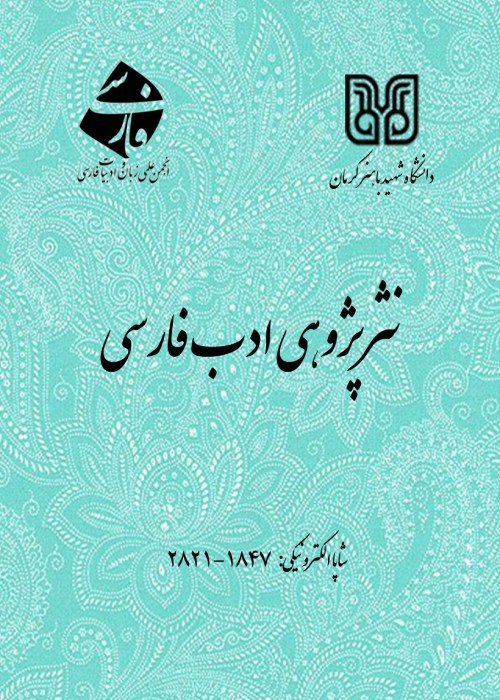The Correspondence of Existential Worlds in the Thought of Sheikh Alaa-Douleh Semnani
As a verb, the term “Correspondence” means “to look at each other” (in Persian culture, under the word, “تناظر”, “Tanaazor”), “to confront” (in the dictionary under the word “Movajeheh”, “مواجهه”), and to match; as a noun it means similarity. In mystical terms, “correspondence of cosmoses” is the similarity and/or confrontation of the two universes, i.e. the microcosm, and the macrocosm, despite their contemporaneity. One of the clear examples of this is the correspondence of the dimensions of human existence with other universes. In the mystical discussion of “correspondence”, the basis of creation is the correspondence of the cosmoses; the emergence of various aspects of creation is visible in the two worlds ‒ macrocosm and microcosm ‒ and shows the interconnectedness of the parts and elements of these two worlds. Mystics believe that whatever exists in the visible world and the macrocosm, has its example existing in the microcosm. In his works, Sheikh Ala-o-Dowleh Semnani, one of the mystics of the 7th and 8th centuries AH, has used the principle of the correspondence of the worlds, depicting the gist of his special mystical teachings such as 'Lataif Sab’a', and the question of creation of man. The issue of dualism is present in all his topics, including the principles and branches of religion, theoretical views of mysticism, etc.
This study, through a descriptive-analytical method and based on a library study, seeks to analyze and examine the idea of the correspondence of worlds in the works of Sheikh Ala-o-Dowleh Semnani in order to find out the purpose, application, and function of the use of correspondence in his mystical teachings. In the thought of Ala-o-Dowleh Semnani, the events of the universe are related to the affairs of the soul.
Among the preliminaries of the design and explanation of the subject of correspondence in Sheikh Semnani's thought is the explanation of the place of man, the world, and the heart in the system of existence. In one categorization, he divides the universe into two worlds, minor and major, and in another division, while expressing his mystical thoughts, he believes in four types of worlds: horizons, soul, unseen and martyrdom (Semanani, 1362: 70). According to Semnani, the existence of correspondence in the world is an obvious phenomenon that does not require any special reasoning and logic. In his intellectual system, correspondence has various functions, the first of which is the correspondence of the cosmic and personal worlds; the correspondence of these two worlds with each other and familiarity with these worlds is evident in the practical teachings of Sheikh Ala-o-Dowleh Semnani. The second function of the idea of correspondence of the Sheikh is evident in his “Treatise on Chess”, in which, by expressing detailed mystical points about chess pieces, he somehow corresponds it to the chess game of human existence. The Sheikh refers to chess pieces as having a spiritual meaning. The third function and example of correspondence in the thought and works of Ala-o-Dowleh, which is also related to the knowledge of self, ontology, and the heavens, is that he considers a spiritual matter for every cosmic matter. The fourth function of correspondence in Semnani's thought is the subject of mystical lights, which was planned by the mystics before him and somehow evolved with Ala-o-Dowleh. The fifth function of correspondence in Sheikh Semnani's works is the subject of mystical veils, and prophets. In all these cases, we see the establishment of correspondence in the mystical system of Sheikh Semnani.
The idea of the universality of man and the universality of the world is actually the expression of the idea of the “correspondence” of microcosm and macrocosm, which will cause the comprehensive recognition of man as both a microcosm and a macrocosm with its own meaning and place in the system of creation. Using a descriptive-analytical method and based on library studies, this study analyzes and examines the idea of correspondence in the works of Sheikh Ala-o-Dowleh Semnani and shows the purpose, application and function of the use of correspondence in his mystical teachings. By emphasizing the duality and connection between microcosm and macrocosm, Sheikh Ala-o-Dowleh Semnani disputes Ibn Arabi's views on the unity of existence and tries to explain the idea of the correspondence of worlds. It is necessary to understand the idea of correspondence in his thought, in order to know the place of man, the world, the universe, and also the heart as the middle links of this correspondence. All these topics are included under his main mystical thought, Lataif Sab'a. The basis for Semnani's theory of Lataif Sab’a is the principle that, on the one hand, all these Lataif (Subtleties) are the result of the effects of heavenly bodies and elements, and on the other hand, there is a correspondence between the subtleties of the Saba, heavenly bodies, elements, types of lights, types of humans and prophets. From Semnani's point of view, the function of correspondence is manifested in the knowledge of man, the world, and the truth, as well as in monastic education, human existential chess, types of subtleties, lights, and prophets.
- حق عضویت دریافتی صرف حمایت از نشریات عضو و نگهداری، تکمیل و توسعه مگیران میشود.
- پرداخت حق اشتراک و دانلود مقالات اجازه بازنشر آن در سایر رسانههای چاپی و دیجیتال را به کاربر نمیدهد.



